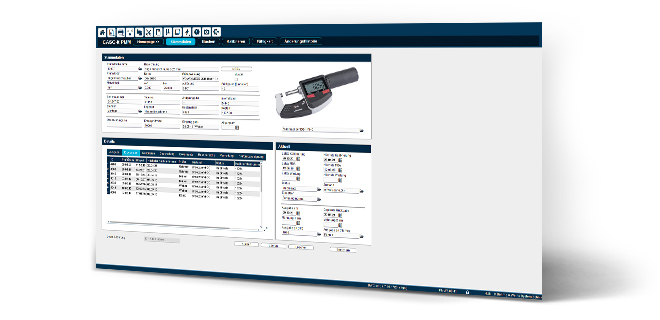
Gauge management software
The gauge management software CASQ-it GMS manages, monitors and documents your company’s inspection device inventory to guarantee the reliability of your inspection systems. Through dynamically-calculated calibration intervals, CASQ-it GMS takes the individual deployment type for each inspection device into account – thus reducing costs. You retain an overview of all the pending calibrations using the integrated deadline monitoring tool and daily due date lists. Standard-compliant capability studies support you with the internal assessment of your inspection systems whilst a standardized calibration data exchange in accordance with VDI/VDE 2623 is used for a collaboration with external service providers. The gauge management software ensures the transparency of your inspection device inventory – so that you can really rely on your inspection results.
CASQ-it GMS functions independently or in interaction with other CASQ-it modules – a customized solution that meets your requirements.
Information package
We are pleased to send you our information package with no obligation.
Development process - GMS
Step 1: Inspection device administration
CASQ-it GMS supports you with the monitoring of single and multi-dimensional inspection devices in accordance with the ISO/TS 16949 standard and under consideration of the requirements set down in ISO 10012 and DGQ 13-61. This gives you the security that your inspection devices always function in full compliance with the standards. Capturing new inspection devices is made particularly easy through a range of sample templates.
Joint calibration and test plans for the same types of inspection device, group calibration plans in accordance with VDI/VDE/DGQ 2618 and DIN buttons for entering the specifications significantly accelerate the generation of your calibration and test plans. Each inspection device has its own master data sheet where you can review all the important details, costs, calibration data and the device history.
Step 2: Inspection device procurement
CASQ-it GMS specifically selects the tests that are required for your particular inspection devices. This means that newly-acquired inspection devices are tested using different criteria to those used for inspection devices that are due for calibration following the expiry of their calibration intervals. CASQ-it GMS provides a seamless documentation of the operational capability of your inspection devices right from day one.
Apart from monitoring standard inspection devices, CASQ-it GMS also supports the administration and calibration of equipment used for measuring electrical values. CASQ-it GMS lists these test devices as different measuring devices under one common master data number – for maximum transparency and traceability.
Step 3: Gauge capability
Use CASQ-it GMS to rule out systematic defects in your measuring processes. CASQ-it GMS achieves this by monitoring and documenting the reliability of your inspection systems through standard-compliant capability studies according to MSA criteria. CASQ-it GMS provides standard-compliant processes, such as capability analysis in accordance with QS9000, MSA, such as R&R, A&R and GR&R – as well as studies by attribute. CASQ-it GMS provides standard-compliant processes, such as capability analysis in accordance with QS9000, MSA, such as R&R, A&R and GR&R – as well as studies by attribute.
You can quickly and easily record the data from your capability studies by connecting the inspection device via interface, a Q-DAS interface or by manual entry. CASQ-it GMS communications with the other modules of the CASQ-it family are process-oriented: Defective inspection devices are automatically locked out of the operational planning process for your inspections in the incoming goods, outgoing goods, manufacturing and production part approval process areas.
Step 4: Maintenance
CASQ-it GMS dynamically calculates the calibration intervals – taking the deployment type and location as well as the number of tests conducted and assignments into consideration. Use this tool to optimize your monitoring intervals and head for a reduction in your testing, maintenance and calibration costs.
The independent deadline monitoring tool – which includes an integrated reminder feature – ensures observance of the respective calibration cycles. Automated return requests and daily calibration and maintenance lists simplify the inspection device collection process.
Step 5: Calibration data exchange
CASQ-it GMS is a synonym for a particularly high level of efficiency – especially when collaborating with external calibration service providers: The exchange of data between your company and your calibration laboratory is done in a standardized exchange format in accordance with VDI/VDE 2623 – a format that Böhme & Weihs played a major part in developing – to guarantee that your calibration data are transferred quickly – and above all, securely. CASQ-it GMS autonomously collates all the data required by the VDI/VDE 2623 standard in an XML file which is sent to your calibration service provider.
Immediately following the calibration process, all the order details, test results and the certificate are returned to you in an XML file by your calibration service provider – straight into your CASQ-it GMS system. Without the need for manually transferring the data into the system – a process which is prone to errors – and the extremely time-consuming process of having to enter data multiple times.
Step 6: Inspection device analysis
Comprehensive inspection device analysis and reports not only provide you with a continually updated overview of your inspection device inventory, they also guarantee traceability in accordance with ISO/TS 16949. This is due to the fact that a detailed history is available for every single inspection device – providing full details on all the conducted calibrations, defects, causes and inspection costs. Graphical analysis and individual lists round off your inspection device administration system – for full transparency.



